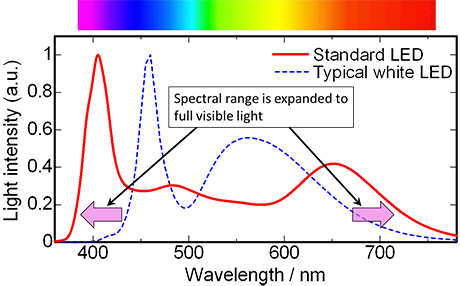
AIST and Nichia developed a standard LED having sufficient light intensity over the full visible light by introducing multiple LED dies with different central wavelengths in combination with multiple fluorescent substances. By using this standard LED, LED manufacturers and developers will be able to evaluate SSL characteristics more accurately, which is expected to help accelerate product development and enhance performance.
Details of the technology will be presented at the FY2015 National Metrology Institute of Japan research achievement meeting held on February 10, 2016, at AIST Tsukuba (Tsukuba, Ibaraki).
Lighting accounts for about one-sixth of residential energy consumption. LED and other forms of SSL consume less energy and are increasingly replacing traditional lighting such as incandescent and fluorescent lamps in order to conserve energy. For that reason, lighting manufacturers around the world are competing fiercely to research and develop SSL. Therefore it is important to inform users of correct performance of each product.
Energy efficiency and color are indices of the lighting product performance and are evaluated by a spectrum derived from spectral measurement. SSL, however, has different characteristics from those of traditional lighting. For example, radiation of SSL is emitted to the forward direction only and spectral distributions of SSL are rich in variety. Because of these differences, there have been no standard light sources suitable for spectral measurement of SSL, making it challenging to measure precisely.
Achieving a standard light source suitable for the spectral measurement of SSL necessitated the characteristic of emitting to the forward direction only, as well as that of having sufficient light intensity over the full visible light (380 nm – 780 nm). A white LED is suitable to fulfill the former requirement, but white LEDs developed to date have not been suitable as standard light sources because even the best of them did not have sufficient optical intensity in the short and long wavelength sides of visible range.
AIST has conducted research and development of total luminous flux standards (as a reference for lighting measurement) and spectral measurement technology, as well as measurement technology for SSL. Through these efforts, it has cultivated high-accuracy spectral measurement and analysis technologies.
Nichia, as a worldwide LED developer and manufacturer, has developed LEDs of high quality and reliability, but it has also sought measurement and evaluation technologies of higher accuracy.
In order to achieve high-accuracy evaluation of SSL characteristics, AIST and Nichia combined AIST's technology for accurate quantitative measurement and analysis of spectra with Nichia's advanced LED technology to develop a standard LED suitable for the spectral measurement of SSL.
For more detail: Researchers develop LED covering full visible light spectrum

